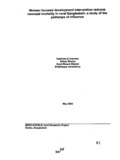Women focused development intervention reduces neonatal mortality in rural Bangladesh: a study of the pathways of influence
Citation
Nasreen, H. E., Bhuiya, A., Ahmed, S. M., & chowdhury, M. (2003, May). Women focused development intervention reduces neonatal mortality in rural Bangladesh: a study of the pathways of influence. Research Reports (2003): Health Studies, Vol - XXXV, 61–83.Abstract
Background: There has been a substantial reduction in hazard of childhood death in
Bangladesh over the last decade. The reduction was much greater in case of infants
whose mothers participated in the development program. However, the pathways through
which development interventions influence neonatal survival remain to be explored.
Objective: Study the impact of BRAC's women focused development interventions on
neonatal mortality in Matlab.
Methods: A case-control study comprising 117 cases (died within 28 days) and 351
controls (live children taken from the nearest door of cases) born during the year 1999-
2000 was employed. Twelve case studies from both cases and controls were done to
complement the quantitative data. ICDDR, B surveillance database provided the
sampling frame. The risk ratio was estimated to see how BRAC program participation
reduces risk of mortality, and stratified analysis was done to see the effects of third
variables over the association. Finally, log regression was done to see the net effect of
variables on neonatal death.
Results: Neonates of BRAC non-members were at 1.9 times increased risk (CL; 1.09-
3.25) of dying compared to neonates of BRAC members. This association works through
two intermediate variables including antenatal care and family planning. Mothers' age
and fathers' occupation acted as confounders over this association. Physical violence
against mothers and psychological stress, pre-maturity and low-birth-weight had
respectively 2.2, 1.7, 13 and 2 times increased risk of neonatal death. However, BRAe
membership did not have any influence over these factors. When simultaneously
accounting for all variables in a multivariate log regression, a dose response association
was maintained for antenatal care, family planning, physical violence and pre-maturity.
Conclusion: There has been a substantial reduction of neonatal morality among mothers
who participated in BRAC intervention. For an effective reduction of these deaths,
program planners should think about ways to address all risk factors together rather than
antenatal care and family planning alone.
Acknowledgements: The financial support of the Ford Foundation and Aga Khan Foundation is
acknowledged.

